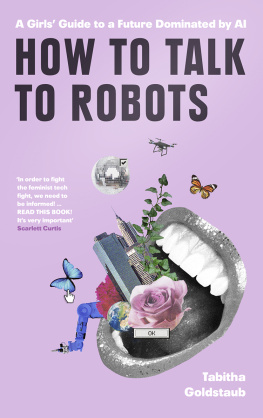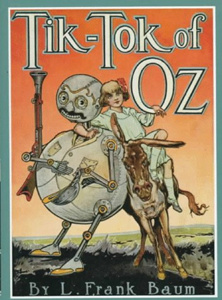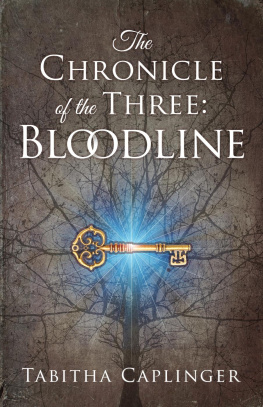Tabitha Goldstaub - How to Talk to Robots
Here you can read online Tabitha Goldstaub - How to Talk to Robots full text of the book (entire story) in english for free. Download pdf and epub, get meaning, cover and reviews about this ebook. year: 2020, publisher: HarperCollinsPublishers, genre: Romance novel. Description of the work, (preface) as well as reviews are available. Best literature library LitArk.com created for fans of good reading and offers a wide selection of genres:
Romance novel
Science fiction
Adventure
Detective
Science
History
Home and family
Prose
Art
Politics
Computer
Non-fiction
Religion
Business
Children
Humor
Choose a favorite category and find really read worthwhile books. Enjoy immersion in the world of imagination, feel the emotions of the characters or learn something new for yourself, make an fascinating discovery.
- Book:How to Talk to Robots
- Author:
- Publisher:HarperCollinsPublishers
- Genre:
- Year:2020
- Rating:3 / 5
- Favourites:Add to favourites
- Your mark:
- 60
- 1
- 2
- 3
- 4
- 5
How to Talk to Robots: summary, description and annotation
We offer to read an annotation, description, summary or preface (depends on what the author of the book "How to Talk to Robots" wrote himself). If you haven't found the necessary information about the book — write in the comments, we will try to find it.
How to Talk to Robots — read online for free the complete book (whole text) full work
Below is the text of the book, divided by pages. System saving the place of the last page read, allows you to conveniently read the book "How to Talk to Robots" online for free, without having to search again every time where you left off. Put a bookmark, and you can go to the page where you finished reading at any time.
Font size:
Interval:
Bookmark:


Tabitha Goldstaub is a tech entrepreneur and co-founder of CogX. She is also the chair of the UK Governments AI Council. How to Talk to Robots is her first book.

Australia
HarperCollins Publishers Australia Pty. Ltd.
Level 13, 201 Elizabeth Street
Sydney, NSW 2000, Australia
www.harpercollins.com.au
Canada
HarperCollins Canada
Bay Adelaide Centre, East Tower
22 Adelaide Street West, 41st Floor
Toronto, Ontario M5H 4E3, Canada
www.harpercollins.ca
India
HarperCollins India
A 75, Sector 57
Noida, Uttar Pradesh 201 301, India
www.harpercollins.co.in
New Zealand
HarperCollins Publishers New Zealand
Unit D1, 63 Apollo Drive
Rosedale 0632
Auckland, New Zealand
www.harpercollins.co.nz
United Kingdom
HarperCollins Publishers Ltd.
1 London Bridge Street
London SE1 9GF, UK
www.harpercollins.co.uk
United States
HarperCollins Publishers Inc.
195 Broadway
New York, NY 10007
www.harpercollins.com

Me, Tabitha Goldstaub
G rowing up, my brother and I played Gameboy incessantly. Yoshis Dream World, Mario Kart Racers, Tekken. The gaming world was full of beautiful pixelated landscapes. I loved the thrill of the win. For me, gaming was a non-gendered space. My household was one dedicated to fashion: my mother was a magazine editor, my father a textiles merchant. So I grew up sitting on the floor of fashion shows, but often more entranced by my Gameboy than the clothes on the catwalk.
In 1995, when I was ten, my parents bought me one of the very early home computers. It was proudly positioned in the kitchen, where I would spend hours absorbed in the Microsoft Paint program, creating personalised desktop backgrounds for each member of my family. I felt like a tech Picasso computers were for art not engineering.
At school, the door to the Internet was Ask Jeeves, a British butler who fronted the search engine, and my guide to Word and Excel was Clippy, Microsofts helpful paperclip mascot. I remember having a Tamagotchi that was neither boy nor girl. All this is to say that I was happily unaware of the notion that gender could ever play a part in technology. It was not a male or female thing: it was my thing.
Cut to a few years later, and during mandatory GCSE IT classes, I was bored out of my brain. We were being shown how to run a doctors reception and were using mail merge to access patients data and send emails. I was not inspired. Thinking about it now, its little wonder I was unable to see technologys true potential. I knew it could make a job as a receptionist more efficient and less repetitive, but what if my teachers had explained to me that tech could help predict which of my patients would need life-saving treatment? Maybe I would have gone on to study computer science. Instead, I followed in the footsteps of my grandpa and set about joining the advertising world. I was genuinely fascinated by the clever people behind the slogans, billboards and TV ads that captivated mine and my friends impressionable minds. At that point I was enamoured and not yet fearful of their power.
Before university, I was working in a pub when brand new fully computerised till systems were installed. The manager decided to train the men on the tills first, which meant they became better faster and so were assigned more shifts behind the bar. The women ended up waiting tables. I didnt even stop to think about whether this division was fair I thought computer stuff wasnt for me, and I think I just accepted that the guys should do the tills. But the consequence of this mindset meant I inadvertently accepted lower pay: waitresses earned less than bar staff, and I ended up hating a job I had come to love. What on earth had happened to me in those interim teenage years?! I still dont know at what point it became the norm that the world of computers was a male one.
By the time I arrived at university to study advertising, new developments with the Internet had set the world alight. Ask Jeeves was no longer the gatekeeper to information now I could research anything and share it immediately. Users had also started communicating with each other directly, and I remember waiting for my university email to grant me access to The Facebook (as it was known back then), which was in its infancy as an American college social-networking platform. The nature of communication was changing, and my chosen route had begun to feel outdated. Peoples minds were not going to be made up by old-school advertising. I was falling in love with the Internet, with the endless opportunities it presented and its immediacy and scale.
Over the course of those three years, I chose modules that would enable me to redefine my relationship with computers. This included how to code. But I found that my dyslexia and my lack of confidence held me back. I was, quite honestly, hopeless. My real aha moment came when I was introduced to Squarespace, a tool that meant I didnt have to write code in order to create a webpage and reach people through the Internet. There were companies and products being released every day that meant people like me, who didnt get on with coding, could still benefit hugely from opportunities available on the web.
All the advertising agencies at which I interned during my degree treated digital campaigns as the second division, and often relegated women to the same position. I felt pretty downtrodden. But the start-up world seemed to have a different vibe. From afar, Id watched Martha Lane Fox, the co-founder of lastminute.com (who youll read about later), take equal billing with her male co-founder as they reached millions online. It seemed like a level playing field, and this excited me endlessly.
So, in 2008, on my hunt to either start a business or work for a start-up, I met Charlie Muirhead, the CEO and Founder of t5m, a new style of digital studio that co-produced awesome online video content with celebrities. I joined as an intern, learning how to add words and codes to propel each video to the top ranks of YouTube and then distribute them across the Internet. When I was promoted to managing a team of other recent graduates, we soon realised that the more laborious, mechanical aspects of our job had to become automated for full efficiency and to avoid us going mad! I relished the opportunity to work more closely with the engineering teams to make this happen.
During this time, the production part of the business had some great successes, but our part-human part-software team were truly flying. The business pivoted, and we concentrated solely on building the technology to enable us to distribute other peoples videos. Seeing those online views rack up was everything to me. I was hooked: how could we get more views and faster?
Font size:
Interval:
Bookmark:
Similar books «How to Talk to Robots»
Look at similar books to How to Talk to Robots. We have selected literature similar in name and meaning in the hope of providing readers with more options to find new, interesting, not yet read works.
Discussion, reviews of the book How to Talk to Robots and just readers' own opinions. Leave your comments, write what you think about the work, its meaning or the main characters. Specify what exactly you liked and what you didn't like, and why you think so.









